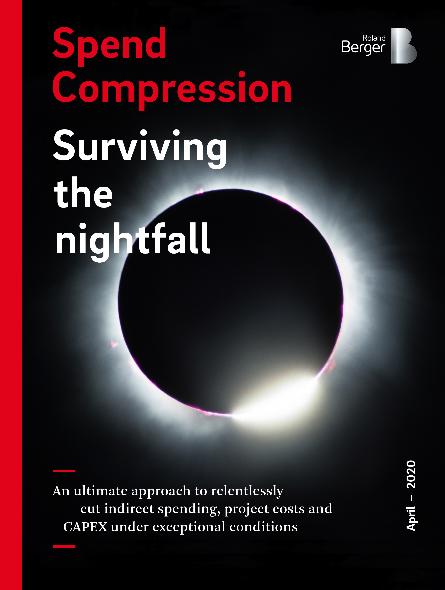Spend Compression: Cutting costs under exceptional conditions
![{[downloads[language].preview]}](https://www.rolandberger.com/publications/publication_image/rb_sal_20_013_spend_compression_online_200409_cover_download_preview.jpg)
Our Spend Compression approach helps companies swiftly cut costs in a crisis by up to 30% while making sure that vital resources remain intact when activities ramp up again.


In the Covid-19 crisis, almost every industry is faced with the existential challenge of slowing down its metabolism immediately but still making sure that it has enough resources after the pandemic's turning point to swiftly return to growth. For that to succeed, it’s crucial to stop non-essential expenditure quickly, while consistently exploiting the possible one-off effects.
In this unprecedented situation, companies should establish a cost-cutting task force at the front line. The approach: each business unit decides which expenditures are to be stopped immediately, reduced or delayed, tightly supported by the procurement department. It’s about shifting the focus now, from long-term strategic operations to resisting the acute and life-threatening challenges – while keeping in mind that a functioning strategic supplier network will be crucial for the way back to normal.
Against this background, a well considered but immediate and relentless reduction of indirect material costs, project costs and CAPEX becomes a lever of enormous value. Roland Berger’s Spend Compression approach helps companies cope with this challenge – it's fast, precise and effective.

Postpone expenditures or limit them to the bare essentials – relentlessly. This creates additional short-term impact and is the key to a swift recovery.
Indirect, i.e. non-product related materials (NPM) have often been shabbily treated in cost reduction projects. And if they do matter, project scopes and measures are typically adjusted to the classic topics, e.g. travel expenses, vehicle fleet or cleaning services. However, it’s worth taking a look at the full NPM spend and challenge, such as CAPEX, especially machinery and building projects, IT, all kind of maintenance or indirect plant spend. Furthermore, project costs and other investments have to be taken into account.
This requires a regular check what is being purchased and what investments are necessary. Ideally, based on those reviews, companies can develop better lines of argumentation for price negotiations with suppliers.


![{[downloads[language].preview]}](https://www.rolandberger.com/publications/publication_image/rb_sal_20_013_spend_compression_online_200409_cover_download_preview.jpg)
Our Spend Compression approach helps companies swiftly cut costs in a crisis by up to 30% while making sure that vital resources remain intact when activities ramp up again.